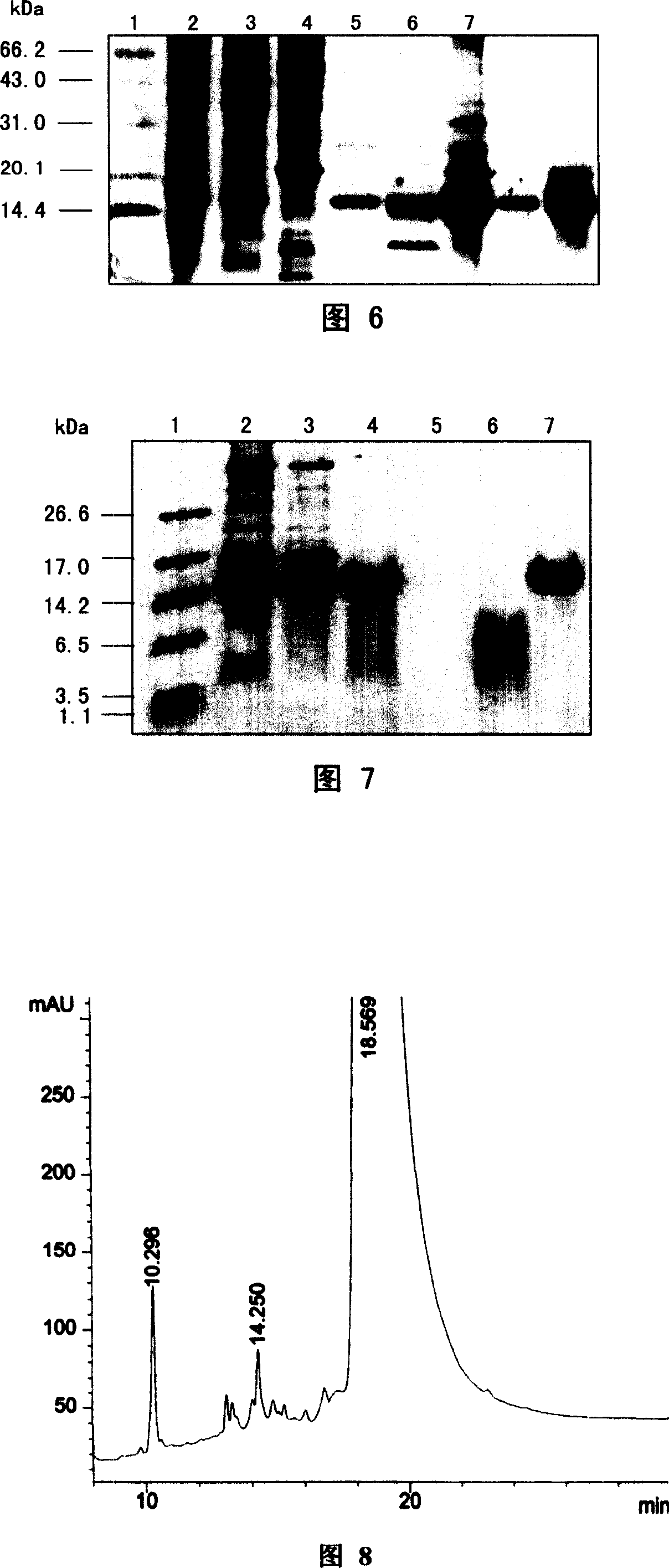Toxic sequential, its preparation and use
A technology of cono snail and thread pattern, which is applied to the new thread pattern conotoxin sequence, preparation and application fields, can solve the problems of in vitro expression of rare cono toxin genes, and achieve the effects of delaying inactivation and prolonging the opening time.
- Summary
- Abstract
- Description
- Claims
- Application Information
AI Technical Summary
Problems solved by technology
Method used
Image
Examples
Embodiment 1
[0038] Embodiment 1: Construction and identification of the lined cono venom cDNA library:
[0039] Extraction of total RNA and synthesis of cDNA: Isolate the venomous tubes of Cono snails, and extract total RNA from the venomous tubes according to the instruction manual of TRIZOL reagent from Gibco BRL Company. Take 1 μg of the total RNA of Cono snail venom tubes, and use SMARTIII olignuclotide (5′-AAGCAGTGGTATCAACGCAGAGTGGCCATTATGGCCGGG-3′) and CDS III / 3′PCR primers (5′-ATTCTAGAGGCCGAGGCGGCCGACATG-d(T) 30 N -1 N-3′) was reverse transcribed to synthesize the first strand to obtain 10 μl of cDNA first strand product. 2μl of the first-strand product was washed with 5’PCR primer (5’-AAGCAGTGGTATCAACGCAGAGT-3’), CDS III / 3’PCR primer (5’-ATTCTAGAGGCCGAGGCGGCCGACATGd(T) 30 N -1 N-3') for second strand amplification. After digesting and purifying the second chain with proteinase K, it was cleaved with Sfi I and ligated into the pcDNA3.0 library vector (purchased from Invitrogen)...
Embodiment 2
[0040] Embodiment 2: Sequence Analysis of Conotoxin S6.8 Gene
[0041] The plasmid and sequence of the conotoxin S6.8 gene were obtained from the gene cluster of strivd4 (QID) in the library of Example 1. Bioinformatics analysis of it showed that its full-length cDNA sequence was 601bp in length, and its reading frame encoded 78 amino acid residues, including a 25-amino acid signal peptide, a 26-amino acid leader peptide and a 27-amino acid mature peptide. Its signal peptide sequence and mature peptide cysteine arrangement (C-C-CC-C-C) are highly conserved with other members of the O-superfamily conotoxins. Amino acid analysis of the leader and mature peptides showed a higher similarity to members of the delta-family conotoxins (see Figure 1). Further analysis showed that the mature peptide encoded by the S6.8 gene of striata conotoxin contained less charged amino acids, and the degree of hydrophobicity was closest to that of conotoxin members of the δ-family. This family...
Embodiment 3
[0042] Embodiment 3: Construction of recombinant conotoxin S6.8 expression plasmid
[0043] According to the amino acid sequence of the mature peptide encoded by the S6.8 gene and the codon preference of Escherichia coli, the template for the PCR reaction was designed and synthesized, and combined with the pTRX plasmid (the applicant constructed and applied for a Chinese patent, the patent name is: a high-efficiency prokaryotic Expression vector, patent number 00124832.4, authorized announcement number 1189565C) multiple cloning site, design the amplification primers of the S6.8 gene fragment, as shown below. A Kpn I restriction site and a ProScission Protease cutting site were introduced into the upstream primer, and a Not I restriction site and a double stop codon were introduced into the downstream primer. After the PCR product is digested with Kpn I and Not I and connected to the pTRX vector, TRX gene, 6 histidine sequences, protease PreScission Protease recognition site s...
PUM
| Property | Measurement | Unit |
|---|---|---|
| molecular weight | aaaaa | aaaaa |
Abstract
Description
Claims
Application Information
 Login to View More
Login to View More - R&D
- Intellectual Property
- Life Sciences
- Materials
- Tech Scout
- Unparalleled Data Quality
- Higher Quality Content
- 60% Fewer Hallucinations
Browse by: Latest US Patents, China's latest patents, Technical Efficacy Thesaurus, Application Domain, Technology Topic, Popular Technical Reports.
© 2025 PatSnap. All rights reserved.Legal|Privacy policy|Modern Slavery Act Transparency Statement|Sitemap|About US| Contact US: help@patsnap.com



